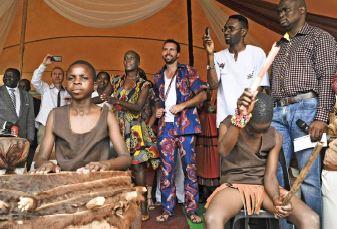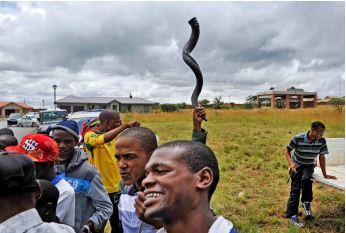Posted on April 23, 2013
In loving memory of Onako-Nokhanyo-Mhlana

Pregnancy also extended to our livestock, which had to be cared for and prepared for labour and feeding. We lived off the land, off the provisions of our plants and animals, so when our cows were lactating, it was with very humble ease that a designated person would milk the cows so we may have food. This skilled person knew to take only enough for our meal, and to leave enough for feeding the new calves. We lived symbiotically with the environment and sentient around us.
My grandfather was considered wealthy, measured by the number of livestock he controlled. Of all the livestock - goats, sheep, and cows - the latter held the most value. As a result, we never slaughtered a cow in our compound until there was an occasion fitting enough to put one down; such as my grandmother's funeral. This is the role of cows in Sepedi belief systems: cows function to connect, to bridge, and to invoke. They exist in a liminal space between the human and divine, the physical and spiritual, the alive and the ancestors, the worldly and the universal.
Let me elaborate. Cows are approached for slaughter when there is a funeral. They function to appease the ancestors so they may welcome one of their own to their realm. The slaughtering of a funeral cow is intricately executed by a designated family member or member of society. They know the protocol to observe in order to appease this cow to sacrifice itself. One may not just take a cow and kill it without ritual. Therefore you perform a ritual for the cow so it may facilitate a ritual for the humans and the ancestors. And you never kill a cow in front of other cows, as we have seen in these terrible slaughterhouses.
The slaughtering of a cow is an occasion on its own. No part of a cow goes to waste. There is order and temporality in the handling of a cow from the moment it takes its last breath. Depending on the different cultures, specific organs are reserved for specific members of the family, and the slaughterer. In Sepedi culture, the liver is usually reserved for the slaughterer, who will always have a small fire next to a place where he slaughters. He usually immediately grills this liver lightly on that fire. The heart is for the senior male of the house. The tripe is given to the senior female members of the house, who will cook it in the large quantities and serve it to other members of the family.
There are people who congregate in the ritual of slaughtering this cow, who usually drain the blood from the cow, leave it to set, and eat it. This is called bobete, and it refers to the curdled blood which reveals to us the clearest connection with ancestors through blood. Those who fancy themselves hunters and herdsmen usually feast on the head of the cow once it has cooked. The meat of the cow is to be handled with care, and is usually eaten whilst fresh, as opposed to freezing it for later use. In this regard, the womenfolk who handle the meat know the different parts to share with specific parts of the family upon departure at the end of the ceremony. It is all ordered and holy. The cow serves to connect two or more families.

The horn of the cow/bull is also put to use in customary processions. The horn provides sonic reverberations that, when blown, may be used to call members of the community far and wide to gather for whatever purpose: emergency situations, judicial meetings, celebrations, and announcements of new developments. This horn is called a phalafala, and is also handled by a skilled individual tasked with keeping it sacred.

The custom of magadi or lobola is celebrated with cows, which are used to unite two families into one. The cows in that context serve to introduce the ancestors of one family to those of the other. A cow will be slaughtered to thank the ancestors for the meeting of these families, and to appreciate that they have allowed the two to merge. The groom's family lets go of their most prized possession in recognition and celebration of the fact that their new bride will take the groom's family name, and possibly expand the family, and by extension, the ancestors.
The rural cow, therefore, is not classified as an animal in Sepedi culture, at least not an animal that queues up for slaughtering as we have been accustomed to in these abattoirs. Cows are part of the family, community, part of the living, part of those who have passed and part of the universe. They exist to humble us and connect us with other realms that may function to heal us. For example sangomas co-exist with cows and rely heavily on them for rites of passages. We need cows more than we need meat, in Sepedi culture. And that is why even in the direst situations of hunger, the cow will be preserved.
Postscript
This is what Mongane Serote wrote as a preface to his poetry book Yakhal'inkomo: "Dumile [Feni], the sculptor, told me that once in the country he saw a cow being killed. In the kraal cattle were looking on. They were crying for their like, dying at the hands of human beings. Yakhal'inkomo. Dumile held the left side of his chest and said that is where the cry of the cattle hit him ... Yakhal'inknomo. The cattle raged and fought, they became a terror to themselves; the twisted poles of the kraal rattled and shook. The cattle saw blood flow into the ground"Â.
In this emotionally charged extended metaphor, Serote uses the cow and cattle to symbolise black people under the tyranny of apartheid.
Uhuru Phalafala is a Phd candidate in English Literature at the University of Cape Town and a close friend of the late Onako-Nokhanyo-Mhlana, an Archival Platform correspondent.